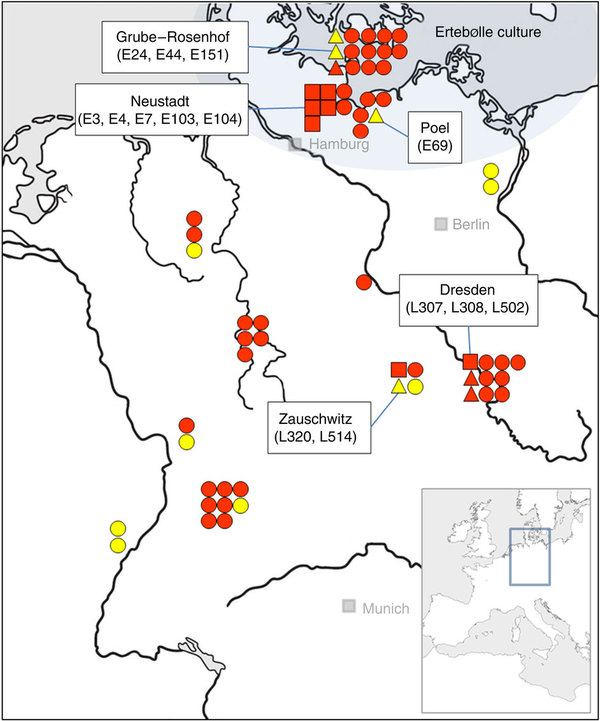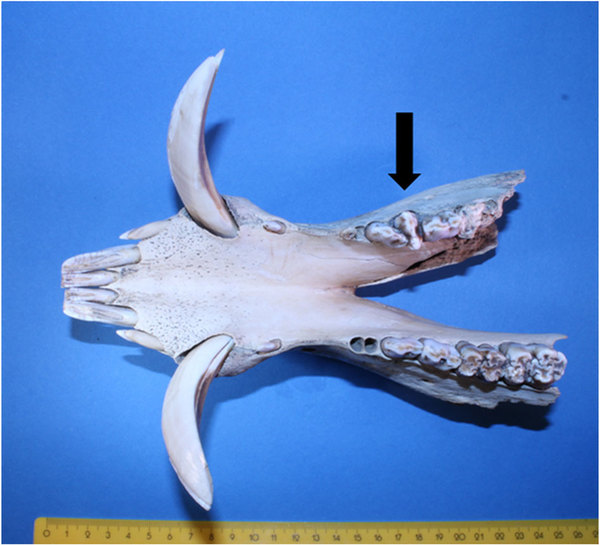European hunter-gatherers owned pigs around 4600 B.C.
I Cacciatori-Raccoglitori europei, stando agli ultimi risultati, erano soliti acquistare maiali addomesticati dagli Agricltori, già nel 4.6oo a.C. circa.
European hunter-gatherers acquired domesticated pigs from nearby farmers as early as 4600 BC, according to new evidence.
Una squadra internazionale di scienziati, includente ricercatori delle Università di Durham e Aberdeen, ha dimostrato che esistevano interazioni tra le comunità di cacciatori- raccoglitori e quelle di allevatori, con scambi di animali e di conoscenze.
 |
| Ben Krause-Kyora pulls out a tooth from the lower jaw of a pig to extract ancient DNA from it [Credit: Copyright: Graduate School Human Development in Landscapes (GSHDL)] |
The international team of scientists, including researchers at Durham and Aberdeen universities, showed there was interaction between the hunter-gatherer and farming communities and a 'sharing' of animals and knowledge. The interaction between the two groups eventually led to the hunter-gatherers incorporating farming and breeding of livestock into their culture, say the scientists.
La ricerca, pubblicata in Nature Communications (27 agosto) dà una buona visione ravvicinata dei movimenti degli uomini preistorici e dello sviluppo delle tecniche e delle conoscenze.
La ricerca, pubblicata in Nature Communications (27 agosto) dà una buona visione ravvicinata dei movimenti degli uomini preistorici e dello sviluppo delle tecniche e delle conoscenze.
The research, published in Nature Communications today (27 August), gives new insights into the movements of pre-historic humans and the transition of technologies and knowledge.
La diffusione di piante e di animali attraverso l'Europa tra il 6000 ed il 4000 a.C. si basò su un complesso gioco d'interazioni tra i cacciatori raccoglitori Mesolitici indigeni ed i 'nuovi arrivati' agricoltori Neolitici. Ma le dimensioni reali di questa serie complessa di rapporti e la quantità di idee che i cacciatori raccoglitori accolsero dai nuovi venuti sono ancora discussi.
La diffusione di piante e di animali attraverso l'Europa tra il 6000 ed il 4000 a.C. si basò su un complesso gioco d'interazioni tra i cacciatori raccoglitori Mesolitici indigeni ed i 'nuovi arrivati' agricoltori Neolitici. Ma le dimensioni reali di questa serie complessa di rapporti e la quantità di idee che i cacciatori raccoglitori accolsero dai nuovi venuti sono ancora discussi.
The spread of plants and animals throughout Europe between 6000 and 4000 BC involved a complex interplay between indigenous Mesolithic hunter-gatherers and incoming Neolithic farmers but the scale of the interaction and the extent to which hunter-gatherers took ideas from their neighbours remains hotly debated.
I ricercatori sostengono che le prove di un possesso d'animali addomesticati in epoca precedente da parte di cacciatori raccoglitori fino ad oggi sono state saltuarie.
I ricercatori sostengono che le prove di un possesso d'animali addomesticati in epoca precedente da parte di cacciatori raccoglitori fino ad oggi sono state saltuarie.
The researchers say previous evidence about the ownership of domestic animals by hunter-gatherers has so far been circumstantial.
Il primo autore del lavoro, Ben Krause-Kyora, dell'Università tedesca di Christian Albrechts di Kiel, sostiene: "I cacciatori Mesolitici avevano sicuramente i cani, ma non praticavano l'agricoltura e non possedevano oche, maiali, capre o mucche, che furono tutte introdotte in Europa con l'ingresso degli agricoltori nel 6000 a.C.
Il primo autore del lavoro, Ben Krause-Kyora, dell'Università tedesca di Christian Albrechts di Kiel, sostiene: "I cacciatori Mesolitici avevano sicuramente i cani, ma non praticavano l'agricoltura e non possedevano oche, maiali, capre o mucche, che furono tutte introdotte in Europa con l'ingresso degli agricoltori nel 6000 a.C.
Avere dei vicini che praticavano una strategia di sopravvivenza così tanto differente deve essere stata un'esperienza strana e oggi sappiamo che i cacciatori raccoglitori possedevano alcuni dei maiali addomesticati dagli agricoltori".
Lead author, Dr Ben Krause-Kyora, from Christian-Albrechts University in Kiel, Germany, said: "Mesolithic hunter-gatherers definitely had dogs, but they did not practise agriculture and did not have pigs, sheep, goats, or cows, all of which were introduced to Europe with incoming farmers about 6000 BC. Having people who practised a very different survival strategy nearby must have been odd, and we know now that the hunter-gathers possessed some of the farmers' domesticated pigs."
Non si sa ancora se i cacciatori ricevettero i maiali attraverso uno scambio commerciale, oppure cacciando e catturando animali sfuggiti agli allevamenti. Comunque i maiali domestici hanno mantelli maculati o di colore differente, che avrebbe avuto un aspetto 'esotico' per i cacciatori e che potrebbero averli attratti.
Non si sa ancora se i cacciatori ricevettero i maiali attraverso uno scambio commerciale, oppure cacciando e catturando animali sfuggiti agli allevamenti. Comunque i maiali domestici hanno mantelli maculati o di colore differente, che avrebbe avuto un aspetto 'esotico' per i cacciatori e che potrebbero averli attratti.
It is not yet known whether the hunter-gatherers received the pigs via trade or exchange, or by hunting and capturing escaped animals. However, the domestic pigs had different coloured and spotted coats that would have seemed strange and exotic to the hunter-gatherers and may have attracted them to the pigs.
Il co autore Greger Larson, del Dipartimento di Archeologia dell'Università di Durham, aggiunge: "Gli uomini hanno sempre amato le novità e i cacciatori - malgrado il fatto che avessero sempre conosciuto e cacciato i verri selvatici - sarebbero certamente stati attratti dalle macchie ostentate dai maiali allevati nelle vicinanze. Quindi non dovrebbe essere una sorpresa che possibilmente ne ottenessero alcuni prima o poi: ma questo studio dimostra che questo fatto avvenne sorprendentemente presto".
Il co autore Greger Larson, del Dipartimento di Archeologia dell'Università di Durham, aggiunge: "Gli uomini hanno sempre amato le novità e i cacciatori - malgrado il fatto che avessero sempre conosciuto e cacciato i verri selvatici - sarebbero certamente stati attratti dalle macchie ostentate dai maiali allevati nelle vicinanze. Quindi non dovrebbe essere una sorpresa che possibilmente ne ottenessero alcuni prima o poi: ma questo studio dimostra che questo fatto avvenne sorprendentemente presto".
Co-author, Dr Greger Larson, from the Department of Archaeology at Durham University, added: "Humans love novelty, and though hunter-gatherers exploited wild boar, it would have been hard not to be fascinated by the strange-looking spotted pigs owned by farmers living nearby. It should come as no surprise that the hunter-gatherers acquired some eventually, but this study shows that they did very soon after the domestic pigs arrived in northern Europe."
E' stato analizzato il DNA ottenuto dalle ossa e dai denti di 63 maiali rinvenuti nel Nord della Germania, che dimostrerebbero che i cacciatori-raccoglitori acquisirono maiali domestici di varie taglie e colori aventi ascendenze medio Orientali ed europee.
E' stato analizzato il DNA ottenuto dalle ossa e dai denti di 63 maiali rinvenuti nel Nord della Germania, che dimostrerebbero che i cacciatori-raccoglitori acquisirono maiali domestici di varie taglie e colori aventi ascendenze medio Orientali ed europee.
 |
| Cartina delle zone dove sono stati effettuati i ritrovamenti |
 |
| Vista dall'alto di una mandibola di maiale, scala in cm. (altre figure nel testo di cui è dato il link, con la scala filogenetica). |
Source: Durham University [August 27, 2013]